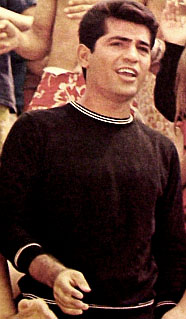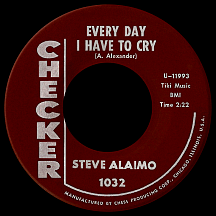STEVE ALAIMO
Every Day I Have to Cry
As far as I'm concerned, singer-songwriter-soul man Arthur Alexander created one of the most emotionally effective songs of the 1960s, though he didn't actually record "Every Day I Have to Cry" until many years later. Instead, it was Steve Alaimo's 1963 version that made the greater impact, though it was only a minor hit at the time. Alaimo didn't exactly become a big star, but he did have his moments, working in the entertainment industry for many years in several capacities: singer, songwriter, record producer, television host and film actor. The list of songs he recorded is far from skimpy, numbering more than 50 singles and several albums over a stretch of about 14 years...and though he never reached the top 40 ("Every Day" came closest), he landed more than a dozen singles on the national music charts.
While attending the University of Miami in Coral Gables, Florida, the still-teenage Alaimo joined The Red Coats, which included his cousin, guitarist Jim Alaimo, drummer James "Chris" Christy and bassist Brad Shapiro, forming a friendship and working partnership with the latter that lasted many years. The band's debut single, "Home by Eleven," appeared in 1959 on the local Dade label and was followed by two on Henry Stone's Marlin Records, "I Want You to Love Me" and "She's My Baby." Each was stronger than the previous, the last one rocking best with a growling lead vocal by Steve; it was followed by one other Dade disc, a teen ballad, "Love Letters." All of the group's recordings were credited to Steve Alaimo and the Red Coats, but none of them received much airplay outside the Miami area.
The Red Coats had called it quits by the summer of '60 when Steve began his lengthy solo career with "Blue Fire," a "Fever"-inspired tune on the Dickson label, picked up shortly afterwards by the larger Imperial Records. A somewhat lackluster ballad, "My Heart Never Said Goodbye," and stronger effort "It Happens Ev'ry Time," were also issued by Imperial over the next few months. He worked a day job doing promotion for the Tone distribution company (owned by Henry Stone) and signed a longer-term contract with Chess Records in the spring of '61. Debuting on the company's Checker label that summer with "Big Bad Beulah," a narrative novelty track, he then took different approaches with "All Night Long" and "The Waiting's So Hard," finally making his first, fleeting appearance on the national charts in March '62 with "Mashed Potatoes," an alternate version of the Nat Kendrick and the Swans track (on Dade) from two years earlier; the spud-smashin' dance sensation, of course, took off that spring with Dee Dee Sharp's "Mashed Potato Time."
There were two more failed singles, then near the end of the year, "Every Day I Have to Cry" began picking up radio play; it was a top 20 hit in more than a dozen markets in the early months of 1963, winding up just below Billboard's top 40. A solid brass-based number produced by Bill Justis with a strong, soulful vocal performance by Steve, the record (with its '...can't mix love with money' message) was, perhaps, ill-timed, though it raised Steve's profile several notches. In addition, recording artists far and wide took notice; there were other notable versions including an early Australian single by The Bee Gees in '65, The Gentrys' 1966 garage rock remake and author Arthur Alexander's own version (titled "Every Day I Have to Cry Some") that, coincidentally, also fell just shy of the top 40 shortly after its release in the fall of 1975.
Three Checker follow-ups faltered, with "Don't Let the Sun Catch You Crying" (Louis Jordan's 1946 hit was the best-known version) and "Michael" (the '61 Highwaymen chart-topper) making the best of a somewhat discouraging situation. Imperial put out an earlier Alaimo recording, "Gotta Lotta Love" (written by seasoned pop songwriters Al Hoffman and Dick Manning), a tune so good it's surprising they hadn't gone with it earlier; it had a respectable chart run late in the year. Alaimo moved to ABC-Paramount in early '64 and seemed unfairly plagued by the same lack of interest among radio deejays, but finally popped up on the charts in March of '65 with "Real Live Girl," a Carolyn Leigh-Cy Coleman song from the three-year-old Broadway musical Little Me. Good news: at about the same time, he landed a daily television gig that made him a familiar face in households across the U.S.A.

It's pretty safe to say Steve Alaimo is better remembered as a TV star than as a staple of radio. He appeared regularly on Where the Action Is, an absolutely fantastic series produced by Dick Clark that premiered on ABC's weekday afternoon schedule starting in June 1965; he and Clark had met when the Red Coats backed some of the acts on Clark's Caravan of Stars tour during its stop in Miami back in '59. It was a connection that paid off in spades when Dick hired Steve (and "Don't Bet Money Honey" sweetie Linda Scott) to host the show on-camera while Clark did voice-over introductions to most segments. So why was this show so fantastic, you ask? Turns out it was shot on location across the U.S., mostly on beaches and various vacation spots including ski resorts in the winter months. The filmed program was the closest thing viewers of the '60s had to a daily music video show (not to discredit the many in-studio programs of the same era). Steve and Linda often sang or lip-synced a variety of songs (including their hits on occasion) and Paul Revere and the Raiders provided crazy antics on a steady basis. Alaimo appeared on more than a hundred episodes and performed on most of them, though it was the Raiders who took best advantage of their position, parlaying the exposure into a string of major hits (Freddy Cannon also got in on the "Action," scoring a hit with the show's theme song).
Steve managed a couple of minor hits during the 21-month span of Where the Action Is; "Cast Your Fate to the Wind," a vocal rendition of Vince Guaraldi's great instrumental hit from 1963, rode the charts concurrent with the series' debut, and "So Much Love," from the pens of Gerry Goffin and Carole King, came a year later. In addition, he joined Raiders Mark Lindsay and Keith Allison on "Melody for an Unknown Girl," a remade (but similar) version of a track from the band's Midnight Ride album. Mysteriously released under the name The Unknowns on Parrot Records, it hit the charts in the fall of 1966.
Despite all the TV saturation, Steve continued to struggle in his recording career, failing to connect with a final few ABC 45s. After Action ended in March 1967, he signed with Atco Records, remaining with them through 1970 but never getting above "Bubbling Under" status. He did, however, have success as a producer during this time, teaming with Brad Shapiro on "Love (Can Make You Happy)," a 1969 million-seller by Mercy, a Florida group discovered by Stone. Alaimo also embarked on a probably-best-left-forgotten acting career with featured roles in four ultra-low-budget flicks produced and directed by fellow Miamian William Grefe: 1967's Wild Rebels (about a motorcycle gang), 1968's The Hooked Generation (a drug dealer drama), 1970's The Naked Zoo (an unfortunate late-career move for then-51-year-old cinema goddess Rita Hayworth) and 1972's Stanley (starring a killer snake in the title role)!
Steve Alaimo continued producing (some 1972 Duane and Gregg Allman sessions a historical highlight) and made his last splash as a singer on Entrance Records with a pair of charters (an update of The Drifters' "When My Little Girl is Smiling" in '71 and "Amerikan Music," a tribute to rock and rollers older and more recent, in '72). For years he worked with Henry Stone at Miami's T.K. label, helping several artists (George McCrae, K.C. and the Sunshine Band and others) cruise to the top of the charts during the disco era.


